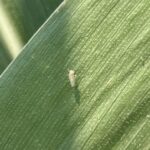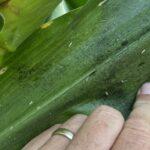 As a continuation of this year’s strange insect problems, we now have Corn Leafhoppers in some corn fields of the Mid-Coast. This insect is not uncommon but showed up in corn fields in the Rio Grande Valley (RGV) a few weeks ago and is now appearing in some local corn fields in numbers great enough to cause concern.
As a continuation of this year’s strange insect problems, we now have Corn Leafhoppers in some corn fields of the Mid-Coast. This insect is not uncommon but showed up in corn fields in the Rio Grande Valley (RGV) a few weeks ago and is now appearing in some local corn fields in numbers great enough to cause concern.
Today, May 24, I visited a Victoria County corn field and found corn leafhoppers in numbers ranging from 1 to 30 leafhoppers per leaf. Most of these insects are below the ear but some plants have them all the way up to the tassel. Some plants have leaf death starting from the bottom of the plant; which shouldn’t be a problem so long as the leaf loss stays below the ear. One to three percent of the plants were heavily damaged and may die.
The corn leafhopper is a small pest, about 5mm in size, and tannish, light yellow in color. You can find the adult corn leafhoppers hopping from leaf to leaf, they are very active/fast, the nymph stages will be crawling fast on the upper or lower sides of leaves. What will give away the presence of corn leafhoppers in your corn is black sooty mold present because of all the honey dew (stickiness) the corn leafhoppers produce as they feed.
The insect is a pest in South America where it is a known vector of several diseases. I do not have confirmation of these disease here in South Texas but adverse plant effects have been noticed on some infested plants.
We believe if your corn in in the brown silk stage, that the stickiness from the honeydew produced should not affect corn yield and that it will be dried down come harvest time were it should not be a problem. For corn in “green silk stage” still, if you have an abundance of these corn leafhoppers present producing large amounts of honey dew, you might want to consider treatment as it could affect the development of your corn.
Due to the rarity of this insect being a pest in Texas corn, our knowledge base is very limited. We have no threshold developed for corn leafhoppers in corn. There are a few insecticides labeled for use in corn that may prove effective. A pyrethroid application in the RGV failed to control the insects; likely due to insecticide coverage issues. Alternative controls are being sought.
We are working with local growers and crop consultants to learn more about this pest and how to manage it.
Insecticides labeled for leafhoppers in corn include:
- Carbaryl
- Pyrethroids
- Sivanto
- Malathion
Information from University of Florida Entomology on Corn Leafhopper biology can be found here: https://erec.ifas.ufl.edu/fciig/frleadm.htm.


